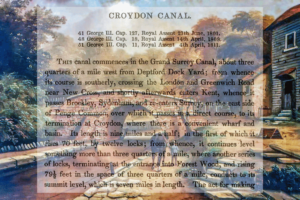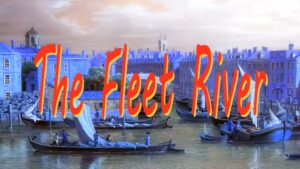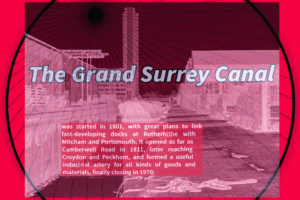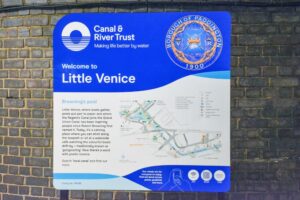Allegedly claimed to be the shortest canal in London, but debatable especially with the modernised Grosvenor canal near Victoria, The sole reason for the existence of McMurrays canal was as a transhipment facility between barges and the Surrey Iron Railway of 1803.
The Wandle is perhaps one of the better known waterways of London. It has always been popular for milling. There were plans to use it for navigation but none came to fruition because of the numerous mills along its length. An item in Canal & Riverboat (August 1981 page 5) does inform us that in 1655 it was recognised the Wandle’s head of navigation was at Wallington Bridge, so it does seem quite possible that rudimentary use of boats or barges was used on the Wandle up until the 17th Century, but little else is known. This would tie in with what is known about London’s other waterway, the Fleet, which has elements of fragmentary evidence of boats sailing as far as Camden Town.
Canals seemed to be the next best option for opening up this part of Surrey to commerce. William Jessop was called in to investigate the conditions for a canal to Croydon. His report was not in favour of a canal as the River Wandle did not have spare water available to supply a canal. Jessop proposed a railway, then quite a radical idea, saying “they have been brought to the degree of perfection which now recommends them as substitutes for Canals; and in many cases they are much more eligible and useful.”

1800: Plans were initially mooted for a Croydon and Wandsworth Canal.
The above extract was taken from The Political State of the British Empire: containing a General View of the Domestic and Foreign Possessions of the Crown…Vol 3 by John Adolphus, 1818.
So began the Surrey Iron Railway. Notice was given on 11 September 1800 of the intention to build this from Wandsworth to Croydon. This gave details of the planned basin/canal at Wandsworth. This was an added element which Jessop had not even mooted but perhaps one that had been made by the railway’s committee.
The Surrey Iron Railway Act of 1801 included “making a Dock or Bason for Barges and other Vessels, with a Lock, Cuts, and other Works from the said railway, at or near Ram Field aforesaid, into Wandsworth Creek, and thereby to communicate with the River Thames.” Plans were clearly changed at some point for in the autumn of 1800 negotiations were under way with the Corporation of London to allow a cut to be built directly from the Thames to serve its basin at Ram Field. The railway itself was to be built from the basin for a distance of eight and half miles “… to or near a place called Pitlake Meadow in the town of Croydon.”

The dates of assignment for the Surrey Iron Railway and its associated works including the canal and basin.
The waterway’s official name seems to have been the Wandsworth Cut. But was also known as ‘Railway Wharf’ and sometimes as McMurray’s Channel. In Hadfield’s earlier books, referring to the Surrey Iron Railway, he mistakenly calls its basin the Grand Surrey Canal. One source cited in “The Making of the British Landscape” (2010) suggests the canal/Surrey Iron Railway began at ‘Frying Pan Creek on the Thames.’ This is another name, rarely used, for Wandsworth Creek.
McMurrays Canal came into being when William McMurray, a Sscotsman from Gorbals, Lanarkshire, bought the paper mills in Wandsworth High Street. These became officially known as the Royal Paper Mills. The Wandsworth Mills were a risky venture where many others had failed, but McMurray made them profitable. The basin and canal were no doubt useful for it enabled direct imports from farms the family controlled in Spain, Algeria and Tunisia.
The mills produced an ultra-thin paper which was excellent for newsprint and thus The Times, The Illustrated London News, The Graphic, The Guardian, The Sporting Life and The Lancet all benefited form this new paper. McMurray also owned the mills (closed 1885) on the River Chess in Rickmansworth, these were accessible via the side cut off the main Grand Junction Canal at Batchworth. It is not known if there was any direct trade between these two mills.

Description for the Wandsworth Cut or McMurrays Canal.
Contracts for the construction of the canal/basin were let on 27 July 1801, plans included the entrance lock and a swivel bridge.The canal itself opened on either 7th or 9th January 1802 (some sources say July 1802, however a report in the Monthly Magazine for February 1802 confirms the earlier date.) a year before the railway itself. Clearly barges were used to deliver some of the materials required for the railway, including its hefty stone sleepers, and no doubt the railway was quite definitely in use prior to its grand opening in 1803. A report from 1802 confirms that “several carriages, of all descriptions, passed over the iron rails, without meeting the least obstacle.” As all had turned out well, in June 1802 the Surrey Iron Railway was considered officially opened as far as Mitcham. Whether the tracks actually reached that town is another matter for consideration as Bayliss says tracks did not reach Garratt Lane until October 1802, whilst McGow says it was early as 23rd September 1802.
A large stage was built over the basin to allow rail wagons to tip directly into the waiting barges. A turntable enabled wagons to run onto this stage, or pier and several cranes were provided to help speed up the transfer between the railway’s wagons and the barges.
Canals were still seen to be the preferred option for in 1809 the Croydon Canal opened, impacting even further on the fortunes of the SiR. As if to reinforce the commercial clout a canal could give, in 1810 Edward Banks proposed a waterway that was intended to link the proposed Grand Southern Canal to either the Surrey Iron or its extension the Croydon Merstham & Godstone Railway. But these were not to be, and in fact no more canals or iron railways were built in Surrey. The Grand Southern scheme was rejected in 1811. In view of the existing iron railway’s flagging fortunes, it was decided to lease the concern. Anthony Lyons, a wharfinger and barge-builder at the Wandsworth basin, took on the new lease in 1819. Leases were the railway’s means of possible fortune until 1846 when it finally closed.

Map showing lock, canal & basins, Ram brewery, the Upper Mills and the Surrey Iron Railway’s route (marked red.)
Despite the success of the Croydon Canal its fortunes were not to last. The expansion of railways soon made itself felt – in face of the inevitable the canal sold out and was converted to a railway. Ironically the older iron railway had outlived the later newcomer, but this was not to last, for it was also on its last legs as the following paragraph will reveal.
The iron route was originally double track, but was eventually reduced to the use of just one line due to the costs of repair. The weight of the wagons easily broke the fragile cast iron rails and costs of relaying with new stronger rails were found too prohibitive. Ritchie, writing in his ‘Railways, their rise and fall,’ published 1846, had this to say: “The whole work is of a coarse description. The plates, being imperfectly laid down, are easily shaken, and the rails present many inequalities…”
Observers wrote of the deployment of donkeys and mules, which were quite unsuited for the purposes of the line. This was clearly an indicator the whole enterprise managed very badly. In time the company gave up the struggle citing that “Traffic along the said Line has ever since the Completion thereof been very small, and has of late years been gradually diminishing and… Receipts… barely sufficient to meet the Expenses of maintaining the Railway…”
Attempts were made to sell the SiR to the fledgling London & Brighton railway company, who wished to use the SiR’s route for a new railway line. These ultimately fell through and the SiR was left with having to deal with its own fate. The line closed on 31 August 1846. In demolishing it’s line, the company began at the Croydon end and worked northwards to the Wandsworth wharves, where its iron rails, stone sleepers and other sundry were offered for sale. Demolition was completed by 1848 and the Surrey Iron Railway was no more.
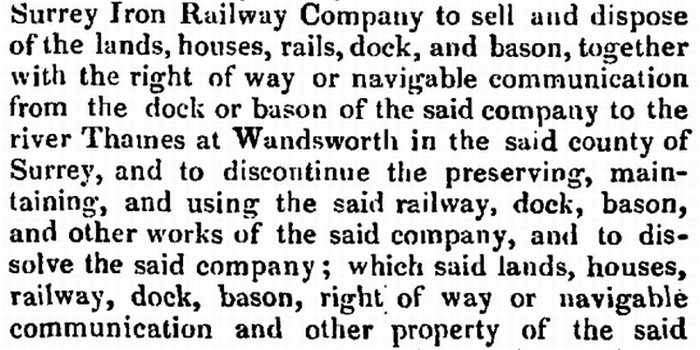
Disposal of the Surrey Iron Railway along with its canal basin.
The canal and lock continued a for a little longer. When the SiR existed it was known as either Wandsworth basin or Railway Wharf. The name McMurray does not come in until later.
In March 1847 it was decided to dispense of the basin and wharves. However it was not until 11 April 1848 an auction was held but found no buyers. A second attempt made in June 1848 saw a sale to Watney and Wells. By 1865 it had ended up under the ownership of William McMurray (or MacMurray.) In 1866 a proposal for a canal to Summerstown (presumably along the old Surrey Iron Railway’s alignment) incorporated the use of McMurray’s, but objections were lodged and the project was dropped. One of the largest objectors was William McMurray himself. Clearly he did not want his mills water supplies compromised.
Contrary to popular opinion, the canal was never actually owned by Youngs Ram Brewery of Wandsworth. However it does appear that from an early date either Youngs (or a man named Alexander and possibly associated with Youngs) were using the canal for the workings of the brewery. In 1871 McMurray expressed concerns to Youngs brewery regarding “an encroachment on land between the River Head or Mill stream and the Canal” as this had caused an inproper function in the mills’ working.
The McMurray’s family heirloom was converted to a limited company in 1891 known as McMurray’s Royal Paper Mills Ltd, with an impressive range of industrial skills and modes of production including “manufacturers, dealers and distributors of paper, card, cardboard, rags, straw, grass, hemp, coal, coke and fuel.” They were also “importers, engineers, owners of boats and barges, stevedoring, unloaders docks and warehouses.” It was sold as a going concern in 1910.
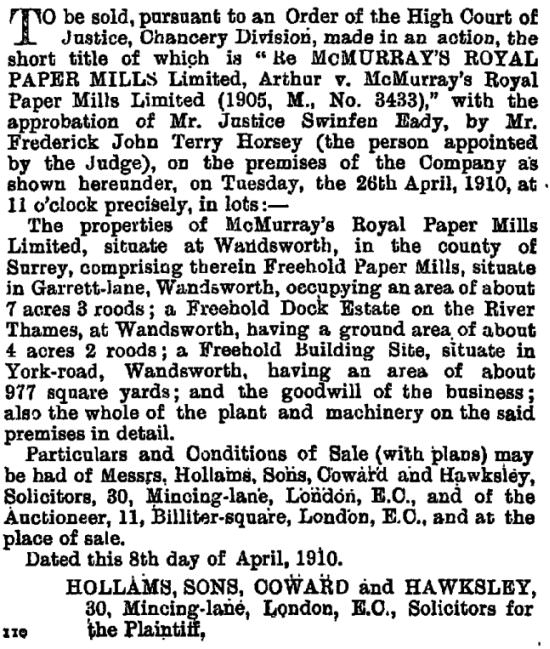
Sale of McMurrays Mill & canal as depicted in the London Gazette April 12th 1910.
McMurray’s mills themselves ended production sometime in the 1920’s and soon after part burnt down. The unaffected bit was converted for other uses, including a cabinet maker’s. By the 1950’s the buildings had become completely derelict, and demolition came in 1962. The Wandsworth Arndale shopping centre stands on the site of the old mills.
McMurrays Canal part two
